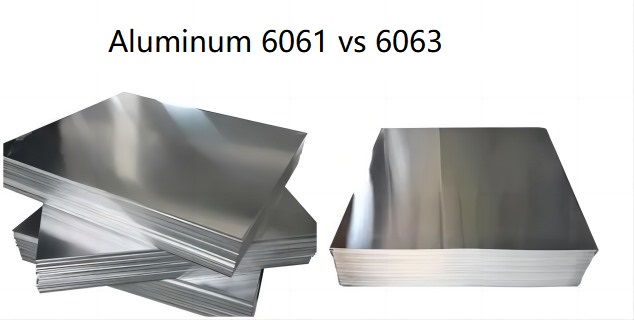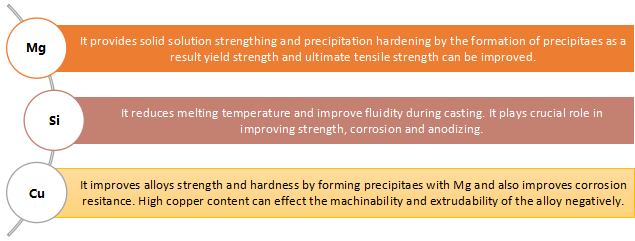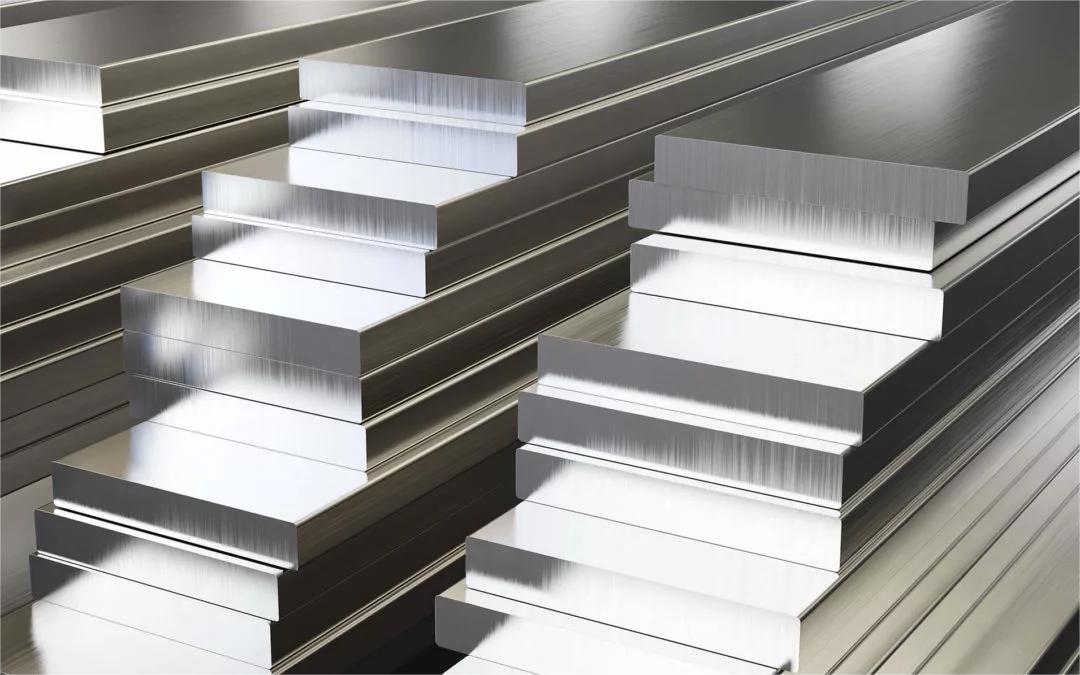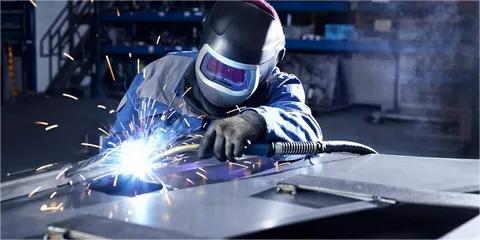6061 vs 6063 Aluminum: What's the Difference Between?
 Jun 01,2023
Jun 01,2023

One-tenth of the mineral reserves are composed for aluminum. As a lightweight, high-strength metal material, aluminum alloy has rich physical and mechanical properties. Aluminum is one of the most famous non-ferrous alloys due to its high strength to weight ratio. This article will describe the differences between 6061 and 6063 in the 6xxx series of aluminum alloys, which are wrought alloys. Main alloying elements of 6061 and 6063 are Silicon and Magnesium.
The purpose of this article is together necessary information regarding both alloys in an article to provide valuable insight into material selection, industrial applications, performance considerations, manufacturing processes, research and development. Both alloys offer quite a big range of applications including aerospace components, electrical components, appliances, automobile body parts, irrigation components and consumer durability. For more information about aluminum metal, refer to our article on aluminum machining.
What can be learned together
Click the links below to skip to the section in the guide:
Aluminum 6061 vs 6063: Chemical Properties
Physical Properties of Aluminium 6061 and 6063
Aluminum Weldability and Processing
Conclusion: The Difference Between 6061 and 6063
6061 or 6063 Aluminum How Should to Choose?

To choose an appropriate material, key features need to be kept in mind as per application. Anodizing capacity of 6061 is inferior than 6063 but it possess relatively higher strength. 6063 is usually preferred when high surface finish and extrusion properties are required in comparison with 6061. 6063 perform well in corrosive conditions in comparison with 6061. Also, 6063 offer higher thermal conductivity as compared to 6061. Both alloys offer good weldability, braze-ability and workability. 6061 exhibit good machinability than 6063 alloy. Electrical conductivity of 6061 is 43% of international Annealed Copper standard (IACS).
What is Aluminum Used For?
- 6061 Alloy square tube: Bar grating, flat bar, ground flat stock, angle drill rode and beams are formed under the umbrella of square tube.
- T5 Aluminum Extrusion: Wall panels, roofing, fences and bathroom fittings are formed through this heat treatment.
- Aluminum Sheet and Plate: Aluminum sheets are passed through high pressure rollers which force the metal into thin plates and even sheets. Due to high malleability of aluminum highly thin sheets can be form which is known as aluminum foil.
- Aluminum Pipe: Pipes of various sizes can be fabricated from aluminum. Aluminum pipe offers good pitting & crevice corrosion resistance, high strength, low thermal expansion and high heat conductivity.
Aluminum 6061 vs 6063: Chemical Properties
High productivity, less quench sensitivity and good combination of mechanical properties are the objective of developing an alloy by in cooperating different element. Table-1 is showing the chemical composition of both alloys.
|
Table 1. Alloying composition of 6061 and 6063 Al alloys |
||||||||||
|
Alloys |
Elements (wt%) |
|||||||||
|
Al |
Mg |
Si |
Fe |
Cu |
Cr |
Zn |
Ti |
Mn |
others |
|
|
6061 [3] |
Bal. |
0.8-1.2 |
0.4-0.8 |
0-0.7 |
0.15-0.4 |
0.04-0.35 |
0-0.25 |
0-0.15 |
0-0.15 |
0.15 |
|
6063 [4] |
Bal. |
0.45-0.9 |
0.2-0.6 |
0-0.35 |
0-0.1 |
0-0.1 |
0-0.1 |
0-0.1 |
0-0.1 |
0.15 |
6061 possess more chromium, copper, magnesium and silicon as compared to 6063 and substantially double the iron as shown in Table-1.
Differences in Alloying Elements
Both alloys have same alloying elements and Mg and Si are main alloying elements. 6061 has higher Mg and Si content than 6063 which attributed as difference in mechanical, corrosion properties and machinability capacity. Role of the main alloying elements is;

According to few researches’, Sr is considered as a grain refiner of aluminum matrix which can further optimized the distribution of precipitates.
Physical Properties of Aluminium 6061 and 6063
6063 exhibits better properties as it has higher thermal conductivity, heat capacity and melting point as compared to 6061. As different heat treatment conditions are given to both alloys but in this article, comparison will be drawn in T6 condition (Solution heat treatment + artificially aged) for both alloys.
Ultimate tensile strength
As both alloys are heat-treatable and strength rely on the heat treatment. T6 conditions is most commonly opted heat treatment and ultimate tensile strength (UTS) of the 6061 is 124-290 MPa whereas 6063 possess 145-186 MPa. UTS is the maximum strength bore by the material before failure which included elastic and plastic deformation on the stress-strain curve. 6061 is stronger than 6063.
Yield strength
Yield strength is the transition point on the stress-strain curve where elastic deformation shifted to plastic deformation. 6061 has higher yield strength which is 276 MPa as compared to 6063 which has 214 MPa.
Hardness
Hardness of 6061 is 107 Hv whereas 6063 has 83 Hv in T6 condition.
Fatigue strength
Fatigue strength of 6063-T6 is 69 MPa whereas 6061-T6 has 96 MPa. ^061 has higher fatigue strength in T6 condition, which shows that can work better under cyclic loadings.
Thermal properties
6061 has lower solidification temperature and lower heat capacity than 6063. Thermal conductivity of 6061 and 6063 is 167 W/mK and 201-218 W/mK, respectively. Co-efficient of thermal expansion of 6061 and 6063 is 2.34*10-5/K. 6063 has higher thermal conductivity than 6061.
Surface finish
Surface finish of 6063 is better than 6061.
Thermal Conductivity
The thermal conductivity of 6061 is 215 W/(m · K), while the thermal conductivity of 6063 is 236 W/(m · K). This means that 6061 has slightly lower performance than 6063 at the same temperature.
Density
Both alloys have same density which is 2.7g/cm3.
Corrosion resistance
Both alloys possess good corrosion resistance due to the formation of 5-10nm dense and stiff oxide layer [9]. Corrosion resistance of the alloys highly rely on the integrity and self-repairing ability of the oxide layer. When surface oxide layer damages, corrosion occurs. These alloys are highly acceptable in atmospheric environment, particularly in marine applications. These alloys are prone to corrosion in the existence of alkaline substances so these are not favorable candidates for stressed bar in concrete. These alloys have low magnesium content (Mg<3.5wt%) which reduce the susceptibility of the alloys for stress corrosion cracking [10]. 6061 is lower corrosion resistant than 6063 alloy. Anodizing is a popular method to improve corrosion resistance of 6063.
Aluminum 6061 vs 6063 Price

Cost of these alloys depends on various factors: price of distributor or supplier, heat treatment condition of purchased product, shape of product and number of the product which is purchased. To get an idea, 42.2$ is the cost of 6061-T6 plate of dimension 12*12 for 1 item. It costs 37.99$ each for 20 items of same dimensions and heat-treatment conditions by saving up to 10% depending on the supplier. As dimensions are increasing, the cost of the product will also increase. Due to change in heat treatment condition, it will also result in cost variation. The cost of 6061-T4 is 7.87$ for 12*12 plate which is lower than 6061-T6. To get an idea of the prices of both alloys, 6061-T6 may cost $220/kg and 6063-T6 may cost $275/kg.
Aluminum Weldability and Processing
As 6061 has high strength and possess lower extrudability and lower surface finish as compared to 6063. Values of extrusion parameters such as pressure and temperature are kept on higher side for 6061 with the fabrication of low quality surface finish. High wear of die and low extrusion speed is also the drawback while considering the extrusion capacity of 6061 as compared to 6063. Based on such capacities 6061 is well suited for structural material. 6063 has good extrusion properties and high surface finish which makes it a best candidate for architectural applications as compared to 6061.
6061 has good machining capability than 6063 and is considered as preferred option where turning, drilling, boring and milling required. 6063 products are dawn in desired shape as per applications where no or minimum machining is needed.
Heat Treatment and Joining Techniques
6061 and 6063 opted heat treatments with slight variations and produce different set of properties. 6061 and 6063 are usually found in T4 and T6 conditions which are naturally aged and artificially aged, respectively. 6063 in T6 condition involved three steps; solution heat treatment at 510 ⁰C, quenching and aging at 175-190 ⁰C for 5-8 hr. 6061-T6 also follows three steps including solution treating at 527 ⁰C, quenching and artificially aging for 10-20 hr at 160-180 ⁰C. After artificial aging, formability and ductility decrease whereas strength and corrosion resistance of both alloys get improved. 6061 has low melting temperature and thermal conductivity that’s why it has slightly higher temperatures for T6 than 6063.
To undo the artificial aging or to lessen the T6 effect in order to get the optimized strength and toughness, anneal 6061 and 6063 at 413 ⁰C for 2-3 hr (at 10⁰C/hr cooling rate) and 415 ⁰C for 2 hr, respectively. Well, temperatures and holding time can be varied as per required properties for specific applications.
Aluminum Welding Technology

Both alloys display good weldability with gas, resistance and electric standard welding methods. Welding techniques which can be implied are; metal inert gas welding (MIG) and tungsten inert gas welding (TIG). 5053 filler is recommended for the surfaces which will be exposed to anodizing and 4043 filler is used in other applications. Heat effected zone can get over aged during welding and reduce its strength. 6063 required lower heat input and filler and produce less distortion along with residual stresses after welding in comparison with 6061.
Which is Better 6061 or 6063?
6063 forms smooth surfaces with complex shapes in comparison with 6063. 6061 and 6063, both are structural material including furniture’s, recreational components truck bodies and window frames. Structures of aircraft components, automobiles bodies, fillings, hydraulic pistons and brakes are manufactured from 6061 aluminum alloy. Also, used in ladders, bridges components due to its high strength and less tendency towards deformation as compared to 6063.
6061 has good conductivity as mentioned earlier so it can be utilized in couplings, electric fillings and connectors. Good corrosion resistance of 6061 make it a good choice material for beverage cans.
Alternatively, 6063 is used in general construction goods such as window frames, stair rails, roofs because it can easily be anodized and can provide good aesthetics. Pipes, trims, structural support, brackets and tubing are also a few applications of 6063. As house-hold aluminum products such as cans can be recycled into more cans due to its ability to oxidation resistance, high corrosion resistance and durability.
If conduction of heat or electricity is important in the application than Al alloys are better option than steels and due to this property, it is utilized in power transmission lines. 6061 has better conductivity than 6063.
Conclusion: The Difference Between 6061 and 6063
Due to their forgeability, both 6061 and 6063 aluminum alloys exhibit exceptional heat treatment capabilities. This alloy can be thermally processed to enhance its mechanical properties, hardness, and strength, among other characteristics. Good strength of both alloys is achieved by solid solution strengthen and aging. Main alloying elements are Mg and Si. 6061-T6 has relatively higher strength and have compromised extrusion properties than 6063. If alloy is intended to use for architectural applications and aesthetics are involved than 6063 is a better choice as 6063 is well suited for anodizing. 6063 possesses better corrosion resistance than 6061.
Also, 6063 has low surface roughness, low distortion and can easily be machinable as compared to 6061. 6061 is used in structural applications. Both alloys have good weldability. It is very important to choose the right material for your application as both alloys have their own pros and cons. In order to make a correct choice, contact us for expert advice. It can’t not be said that one alloy is better than other without specifying the application, as both contain advantages and disadvantages.
FAQs
Are 6063 aluminums bendable?
6063 easily bendable as compared to 6061 and considered as a common practice that bending the alloy in desired geometry in annealed condition then opt T6 heat treatment for desired mechanical properties.
What is the difference between 6061 and 6061-T6 aluminum?
The main difference between 6061 and 6061-T6 aluminum alloys is the presence of different alloy elements.
6061 aluminum alloy contains only a small amount of magnesium and copper to improve its strength and corrosion resistance.
In contrast, 6061-T6 adds titanium to the base 6061 alloy to further enhance its strength, hardness; good heat treatment performance is more conducive to machining and welding.
Therefore, 6061-T6 is generally more suitable for industrial applications that require higher strength and better corrosion resistance than 6061.
Can 6061 and 6063 be welded together?
Yes, 6061 and 6063 can be welded together by utilizing TIG or MIG welding technique. The most common filler rod for welding is ER4043.
What would be 6061-T6 vs 6063-T5?
In 6063-T5, alloy is cool down from elevated temperature and then artificially aged whereas in 6061-T6, alloy is solution heat treated and then artificially aged. 6063-T5 exhibits UTS of 186 MPa and yield strength 145 MPa whereas 6061-T6 gives UTS of 290 MPa and yield strength is 276 MPa. 6061-T6 is stronger material than 6063-T5.
 Tel/WeChat:
Tel/WeChat:  Email:
Email: 
 Home
Home
 3Cr13 Steel: The Complete Guide
3Cr13 Steel: The Complete Guide 







